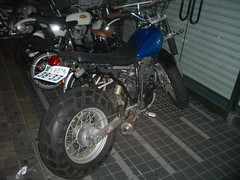In September, Liz and I went to Japan for the Ubicomp 2005 conference. It was my first trip to any Asian country, and like any first-time tourist in Japan, I was overwhelmed by the lights, continually surprised by subtle cultural differences (for example, why are so many restaurants in the basements of buildings in Tokyo?) and enchanted by many aspects of the place (the Great Buddha in Kamakura is awesome).
One thing that struck me about Tokyo is how Modernist it is. By Modernist, I mean more than just "new and shiny" or "made of concrete, steel and glass." Much of it seems to be pre- postmodern (in other words, Modernist), in its design. Unironically minimalist housewares and stationary at Muji and Tokyu Hands. 1920s France- and 1960s US-inspired fashion in Harajuku. Sure the cosplay girls dressed like Victorian babydoll zombie dominatrixes is totally not Modernist, but there were few signs of that attitude spilling over into broader life. Even the current fashion in motorcycles seems ultra-minimal. No more splashy plastic and chrome, it's all about having as little as possible between you and the enormous back wheel on your small-engine 1960s bike.




I'm sure I'm missing the point or misunderstanding a lot of what I see, and people who are more familiar with the cultural indicators can point out where I'm misreading the situation, but what struck me is how the Modernist perspective extends to the way that business of design is managed and handled there. Much of the perspective seems based on a classic Modernist "supply-driven" model, which means that a company produces stuff based on internal gut-level determination of what's interesting (usually done by executives or project managers). Sometimes it sells, sometimes it doesn't. When it sells, they make more. When it doesn't, they don't. You can see the Cohen Brothers' version of this Modernist myth of product design is distilled and presented in The Hudsucker Proxy: Norville has a big idea, everyone thinks it's crazy, but they make it anyway, it's a huge hit, he's a genius. No field research, no usability testing, no focus groups. "You know, for kids!" That movie takes place in a fictionalized 30s/50s past that's the glory era of supply-first thinking. In Akihabara, the big electronics district of Tokyo. I got the feeling that's the perspective that Japanese electronics manufacturers still take. Let's make a bunch of variations on an idea; whichever variation sells more, we'll make more like that. It's a continuous Cambrian explosion of products, with the ideas sorted out by the pseudo-evolutionary forces of market adoption.
This is in contrast to the philosophy I see at work at large American and European companies that have enthusiastically adopted end-user research methods taken from marketing techniques and pioneered by the social sciences (see my discussion with Anne recently about the bumps that this adoption is causing in both the academic and corporate spheres). On the one hand, this is great, and the core of my "demand-driven" philosophy of product development. Too many companies are still doing no end-user needs assessment and research at all. Further, I'm certainly not going to say that user research is ever bad ;-). However, the Japanese way of making and marketing made me rethink my stance about the need to always make decisions based on a priori user research. Maybe, just maybe, the current capabilities to prototype, engineer and distribute product variations on a core idea allows for ideas to be tested, and markets to be primed for the acceptance of new ideas, without conclusive documentation from end-user research. Thinking that there's a single product and a single answer, and that research should continue until that's determined, is an equally Modernist idea, from a time when retooling was incredibly expensive. Now, as one hardware designer in San Francisco told me, it's possible to sketch some ideas on a piece of paper, fax it to China, and have a working prototype designed and engineered in a month, and to have production samples soon thereafter. I'm sure this doesn't work for revolutionary ideas, but ideas based on technologies that the engineers and designers are comfortable with--but that's probably where most hardware designs are.
With technological and design possibilities like this, maybe a hybrid approach is appropriate. One that's not based on the idea that the user research is useless ("they don't know what they want" and all that) and also not based on the idea that only deep, exhaustive field research can produce insights that lead to product features. Maybe the hybrid approach is an iterative one based on iteration between rapid research and feature experimentation. What's an appropriate iteration cycle? The Japanese companies have already settled on a release cycle that's nearly quarterly, with a new version of whatever product released every 3 months. However, the feature set in these seems to be still nearly arbitrary, probably determined by product managers in engineering groups based on what the engineers have developed. Maybe the right hybrid approach is a quarterly release cycle of multiple variations on a product idea coupled with both field research to identify new behaviors that can guide innovation and fairly rigorous evaluation of the popularity and actual use of product features. It can be a kind real world conjoint analysis.
Yes, this would screw seriously with the idea that a company needs to put all its marketing muscle behind a single product and promote it as if no others exist. But maybe it's amenable to another approach, one that markets a product line as a single product, but with options. This is the classic automobile model, though one that's fallen out of favor (as I understand it, most Americans buy cars off the lot these days, rather than custom ordering them and waiting, as they did in the old days; Germans, I believe, still prefer to wait and get just the car they want). Maybe a configurator could narrow the options to just the variations that were built and there wouldn't actually be any customization, just assistance in getting the features you want, while follow-up research figures out what you actually use.
Anyway, the thought that struck me as I saw the rows of nearly-identical MP3 players and phones was "There is great research waiting to happen here, if the people making the stuff and the people obsessing about research could only join forces."











Recent Comments